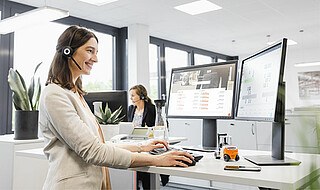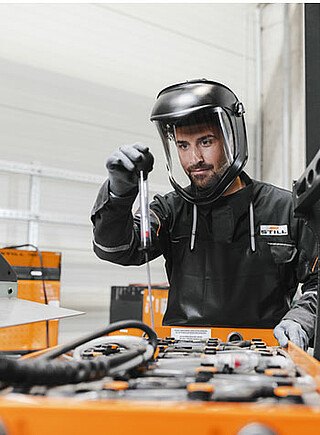How Industry 4.0 is changing service in logistics and warehousing

Industry 4.0 may be bringing a digital revolution to logistics and warehousing, but how is service changing with it? To ensure every customer is well served in this time of change Gillian Reed, UK Service & Operations Director (and her expert team) are using technology to achieve new levels of customer satisfaction.
How is 'Service' changing with Industry 4.0 and what will be the impacts?
In logistics and warehousing I believe the industry has steadily evolved up to this point, which many are coining as Industry 4.0. Unlike the past steam and electricity powered industrial revolutions which were defining product lead revolutions, the change now is a shift in service from your traditional engineering to more data driven businesses. What I’m finding is our service is now broader than ever before as we support both ends of that customer spectrum. We will look after customers with a handful of diesel or gas trucks that will be used as and when, and then on the opposite end of the spectrum some customers will have warehouses with fully automated vehicles that are programmed and optimised to be as efficient as possible.
For us at STILL, the shift to Industry 4.0 means we need to be much broader in our service proposition, a service engineer at STILL has a very different skill set today compared to a few years ago. Yes, the mechanical skills are still required to fix a brake line on a forklift for example, but that same service support will also need the software knowledge when a piece of automated kit has just stopped and nobody knows why. Internally our impact is to have the right people with the right technical skills to support our customers, and that means future proofing ourselves with the latest technology while continuing to serve the more traditional requirements of our industry.
How is STILL's Service software bringing Industry 4.0 to the warehousing environment?
In logistics the software is following the product, if you introduce a new truck or order picker, you’ll need software to get the most out of it. You can have trucks operating and doing the job, but it’s the software that drives the efficiency in the warehouse and increases the productivity of the fleet.
Fleet management software is not a recent introduction to our industry; we’ve made analysis and data production available to the STILL customer for many years now. Software was used to provide information about their trucks, but then it was up to the customer to interpret that data. Today, we are bringing Industry 4.0 to the warehouse with our FleetManager and neXXt Fleet applications. These applications analyse the data for the customer, providing insight and action points based on their fleet usage and helping customers manage their fleet and make efficiency improvements.

Tell us about Service4All and Real-Time Service from STILL?
Service4Alll is an extension to the service available after you purchase a STILL truck, we created it to answer the fact that many of our customers run mixed MHE fleets from different brands. Rather than calling out each company’s service engineer, we offer a service that allows our engineers who have the skill and experience to work on most manufacturer’s equipment. This offers a more efficient service offering for the customer and for us we have the engineer skill and infrastructure to offer a more comprehensive service than our competitors. The Service4All interactions we have with new customers can also lead to new sales of STILL trucks, so the ‘service before sales’ approach benefits both customer and us alike.
Real-Time Service is something we have planned for the future along with other service apps which we are developing. The aim of these apps is to make it easier for the customer to do business with us. For customer experience, as an industry we haven’t been that progressive. We can’t just offer phone or email as a contact method in 2021 anymore. That’s why the apps in development now are integrating vehicle diagnostics and back office systems to enable our engineers to respond quicker.
The size of STILL in the UK also gives us a service advantage, particularly when it comes to the whole market of service support which we offer. We may have a relatively small market share in the UK, but that makes us agile, plus we have the backing from a global manufacturer in the form of the STILL Group. One way to put this, is we 'think locally, but we act globally'. We can offer a faster, more flexible service thanks to our small size, and we have that global STILL Group knowledge behind us, offering quality to the customer.
What other service innovations and technologies are planned for the future?
The other service innovation I’d like to talk about is remote support. Now everyone has heard of the Google Glass concept, and similar solutions available on the market. At STILL we are working on connecting our service engineers in a similar way. In our technical team we already have remote access to the engineers operating out in the filed via their laptops; if the engineer is having a problem, the technical specialists can remote access into the engineer’s laptop and see the truck’s diagnostics. One of the projects that STILL Group is working on, is taking this a step further by utilising a smartphone camera or 'glasses' to give true visibility of what the engineer is seeing on the truck itself. The aim of this is to improve our first-time fix rates which are already strong, but by introducing this technology we can push that even further. Thanks to this technology the scenarios where an engineer is unable to fix first time should be significantly reduced.
How does STILL measure their service levels and value-added to the customer?
Internally we have a plethora of internal measurements like first time fix rates, and uptime of trucks that tell us the performance of our service, I call these the input measures. However, ultimately the one measure worth talking about is our Net Promoter Score (NPS), because that's the output for all of these inputs.
As an industry we have been slow to adopt customer measurements like NPS but fortunately for STILL in the UK, our management has made NPS a metric in which every department, team and employee is measured upon. Over the past seven years we have progressed from a score of 39 to an industry leading score of 77.

We also measure our Customer Satisfaction Index (CSI) which has progressed from 8.7 to 9.15, the way we measure this is by calling customers straight after we've completed a chargeable job which is such an important part - to capture customer experience within 24 hours of any work we complete for them. Thanks to both of our high performing NPS and CSI scores we can show that every employee at STILL contributes to that performance and we have broken down previous assumptions that service is just a metric for the service team. Customer service involves everyone, and our high performing scores demonstrate that.
Are there any plans to expand the current Service teams as part of the new footprint?
For service the new footprint sees STILL having a direct presence in the UK and in January we entered directly into Scotland. With the new footprint in regions where we are direct, we can really focus our energy on expanding our presence. For the regions where we have an allocated Exclusive Distributor (ED), my service team is working with them to expand their knowledge, resulting in a much more expert and locally focused service team available to the customer. For me the exciting part of the new footprint is the ability to have best practice, sharing of knowledge and the expertise of STILL as a manufacturer combined with industry-deep, locally focused insights and experience. The benefit to our ED’s and their customers is they now have access to our support and service experience, plus our support will be far more localised and focused in the right areas where our customers are. Having a local presence is an economic trend we see elsewhere in retail for example, customers may not have a local department store but there may be an outlet of that store within their local supermarket. At STILL we’re applying that same tactic so that we have that local presence and offer faster support.
Find out how our service team can help
With service experts in every region, STILL offer an efficient and market leading support offering to warehouse managers. Speak to our experts to discover how we can improve the servicing of your fleet and MHE. Contact us today!
Comments
No comments
Subscribe to the blog !
Be informed as soon as an article is published. You can unsubscribe anytime.

Leave a comment